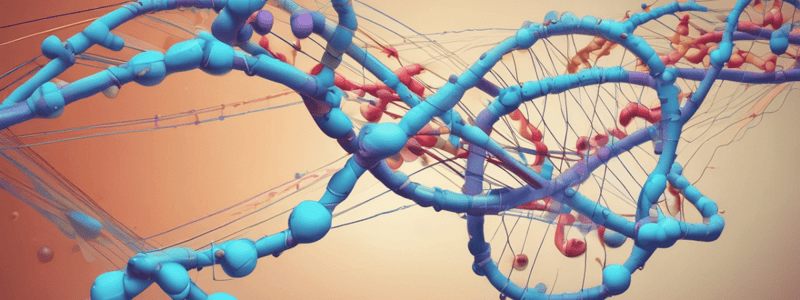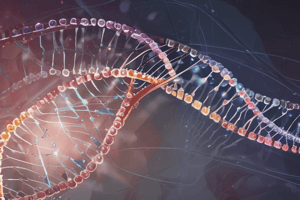Podcast
Questions and Answers
What is the primary reason why the addition or deletion of three base pairs left the distal portion of the gene with the wild-type reading frame?
What is the primary reason why the addition or deletion of three base pairs left the distal portion of the gene with the wild-type reading frame?
- The genetic code is comma-free.
- The genetic code is overlapping.
- Each codon contains three nucleotides. (correct)
- Each codon contains four nucleotides.
What is the result of chemically synthesized mRNA molecules containing repeating dinucleotide sequences?
What is the result of chemically synthesized mRNA molecules containing repeating dinucleotide sequences?
- The synthesis of copolymers with alternating amino acid sequences. (correct)
- The synthesis of a mixture of two homopolymers.
- The synthesis of a single homopolymer.
- The synthesis of a mixture of three homopolymers.
What is the characteristic of the genetic code that allows for consecutive reading of codons?
What is the characteristic of the genetic code that allows for consecutive reading of codons?
- Comma-free. (correct)
- Overlapping.
- Degeneracy.
- Non-overlapping.
Which amino acids are specified by only one codon?
Which amino acids are specified by only one codon?
What is the term for the occurrence of more than one codon per amino acid?
What is the term for the occurrence of more than one codon per amino acid?
How do the multiple codons specifying a given amino acid usually differ?
How do the multiple codons specifying a given amino acid usually differ?
What would be the result of a frameshift mutation, where a single base pair is inserted or deleted?
What would be the result of a frameshift mutation, where a single base pair is inserted or deleted?
What is the significance of trinucleotides in protein synthesis?
What is the significance of trinucleotides in protein synthesis?
What is the characteristic of the genetic code that allows for multiple codons to specify the same amino acid?
What is the characteristic of the genetic code that allows for multiple codons to specify the same amino acid?
Which of the following statements is true about the genetic code?
Which of the following statements is true about the genetic code?
Study Notes
Three Nucleotides per Codon
- Twenty different amino acids are incorporated into polypeptides during translation, requiring at least 20 different codons with the four bases available in mRNA.
- Francis Crick and colleagues published evidence in 1961 supporting a triplet code, using genetic analysis of mutations induced by the chemical proflavin.
Properties of the Genetic Code
- The genetic code is ordered, with multiple codons for a given amino acid and codons for amino acids with similar chemical properties being closely related, usually differing by a single nucleotide.
- The genetic code contains start and stop codons, with specific codons used to initiate and terminate polypeptide chains.
- The genetic code is nonoverlapping, with each nucleotide in mRNA belonging to just one codon, except in rare cases where genes overlap.
- The genetic code is comma-free, with no commas or other forms of punctuation within the coding regions of mRNA molecules.
- The genetic code is degenerate, with all but two of the amino acids specified by more than one codon.
Degeneracy of the Genetic Code
- The occurrence of more than one codon per amino acid is called degeneracy.
- All amino acids except methionine and tryptophan are specified by more than one codon.
- Three amino acids—leucine, serine, and arginine—are each specified by six different codons.
- Isoleucine has three codons, and the other amino acids each have either two or four codons.
- The degeneracy in the genetic code is not at random, but is highly ordered, with multiple codons specifying a given amino acid differing by only one base, the third or 3’ base of the codon.
Codon Structure and Reading
- A single base-pair addition or deletion will alter the reading frame of the gene and mRNA for that portion of the gene distal to the mutation.
- The codon structure can be read in different ways, such as AAA, GGG, CCC, TTT, or AA, AGG, GCC, CTT, T.
- Codons can be grouped into two categories, plus (+) and minus (-), based on whether they result from additions or deletions.
Initiation and Termination Codons
- In both prokaryotes and eukaryotes, the codon AUG is used to initiate polypeptide chains.
- In rare instances, GUG is used as an initiation codon.
- Specific codons are used to terminate polypeptide chains.
Studying That Suits You
Use AI to generate personalized quizzes and flashcards to suit your learning preferences.
Related Documents
Description
Learn about the structure of codons and how they relate to amino acid translation in molecular biology. Discover how the four bases in mRNA form codons and the role of mutagenic agents in genetic analysis.




